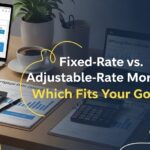Reverse mortgages have gained increasing popularity as a financial solution for retirees seeking to unlock the wealth tied up in their homes while enjoying the comfort of their own space. These unique financial instruments offer a lifeline to seniors looking to supplement their retirement income, cover unexpected expenses, or enhance their overall quality of life.
However, among the attractiveness of reverse mortgages, a fundamental aspect that may dramatically effect the conditions and prices of these loans exists: interest rates.
Whether you’re a retiree contemplating this financial tool or simply curious about how interest rates come into play, join us as we uncover the intricacies of reverse mortgage interest rates in 2024.
Interested in a reverse mortgage? Reach out to Sprint Funding to see how we can help you tap into your home’s equity.
With our expertise, you can navigate interest rates and find the best solution for your retirement. Contact Sprint Funding today and take the first step towards financial security!
Understanding Reverse Mortgages
Reverse mortgages are a financial product tailored to homeowners aged 62 and older, offering a unique way to access their home equity.
 Unlike traditional mortgages, where borrowers make monthly payments to reduce their loan balance, reverse mortgages enable homeowners to receive payments from the lender, effectively converting their home equity into cash.
Unlike traditional mortgages, where borrowers make monthly payments to reduce their loan balance, reverse mortgages enable homeowners to receive payments from the lender, effectively converting their home equity into cash.
Key points to consider:
- Loan Repayment: With a reverse mortgage, borrowers do not need to make monthly repayments. Instead, the loan is typically repaid when the last borrower permanently leaves the home, either through sale, moving out, or passing away.
- Homeownership Retained: Despite receiving payments from the lender, homeowners retain ownership of their homes and are responsible for property taxes, insurance, and maintenance.
- Funding Flexibility: Reverse mortgage funds can be used for various purposes, such as supplementing retirement income, covering healthcare expenses, making home improvements, or simply enhancing one’s quality of life.
- Loan Types: There are different types of reverse mortgages, including Home Equity Conversion Mortgages (HECMs), which are government-insured, and proprietary reverse mortgages offered by private lenders.
The Role of Interest Rates in Reverse Mortgages
When it comes to reverse mortgages, interest rates play a crucial role in shaping these financial tools. They have the power to decide loan terms, affect costs, and determine the financial benefits that borrowers can receive.
As a fundamental aspect of reverse mortgages, interest rates have a significant impact on the associated terms and expenses.
- Determining Loan Terms: The interest rate is a key factor in determining the loan amount available to the borrower. Generally, a lower interest rate allows borrowers to access a larger portion of their home’s equity.
- Impact on Costs: The interest rate directly affects the overall cost of the reverse mortgage. Borrowers should consider how the rate will impact the accumulation of interest over the life of the loan.
- Type of Interest: Reverse mortgages offer borrowers the choice between fixed and adjustable interest rates. Fixed rates provide predictability, while adjustable rates can offer initial savings but may increase over time.
- Loan Proceeds: The interest rate can influence the amount of funds borrowers receive as a lump sum, line of credit, or monthly payments.
Reverse Mortgage Interest Rates: An Overview
Reverse mortgage interest rates play a central role in shaping the financial landscape for retirees, influencing various aspects of the loan. Here, we provide a comprehensive overview of these rates:
Types of Interest Rates
When considering a reverse mortgage, borrowers can opt for either fixed or adjustable interest rates.
Fixed rates offer predictability and stability, as the interest rate remains constant throughout the entire loan term. This can be reassuring for retirees who want to plan their finances with certainty.
In contrast, adjustable rates may start lower, providing initial savings, but they have the potential to fluctuate over time based on market conditions. Borrowers must weigh the benefit of immediate cost savings against the possibility of future rate increases.
Interest Rates in 2024
It’s crucial for prospective borrowers to stay informed about the current interest rate environment. The landscape of interest rates can fluctuate due to economic factors, market trends, and government policies.
Understanding the prevailing rates is essential because it directly impacts the terms of the reverse mortgage. Borrowers can use this knowledge to assess whether it’s the right time to pursue a reverse mortgage or if waiting for more favorable rates might be a prudent strategy.
Factors Influencing Reverse Mortgage Interest Rates
 Reverse mortgage interest rates are dynamic and responsive to various factors, making them subject to change. These rates are not fixed and are influenced by various factors that borrowers should understand:
Reverse mortgage interest rates are dynamic and responsive to various factors, making them subject to change. These rates are not fixed and are influenced by various factors that borrowers should understand:
Economic Conditions
The broader economic landscape plays a significant role in determining reverse mortgage interest rates.
For instance, changes in the Federal Reserve’s monetary policy can have a ripple effect on interest rates. When the Federal Reserve adjusts its benchmark interest rates, it can lead to shifts in the rates offered for reverse mortgages.
Borrowers must stay attuned to these macroeconomic changes, as they can directly impact the costs associated with their reverse mortgage.
Lender Variability
Interest rates for reverse mortgages can vary among different lenders. Financial institutions have flexibility in setting their rates, which can result in disparities between lenders.
As a result, borrowers are encouraged to shop around and compare offers from various lenders to ensure they secure the most favorable terms. This variability emphasizes the importance of conducting thorough research and seeking competitive quotes.
Borrower Profile
The specific attributes of the borrower also come into play when determining the interest rate for a reverse mortgage. One significant factor is the borrower’s creditworthiness.
Lenders may consider the borrower’s credit history and financial stability when determining the interest rate. A borrower with a strong credit profile may be eligible for more favorable rates.
Additionally, the type of reverse mortgage chosen, whether it’s a Home Equity Conversion Mortgage (HECM) or a proprietary reverse mortgage, can influence the offered interest rate. Borrowers should be aware that these factors related to their own profile and the type of loan they select can impact the final interest rate they receive.
Interest Rate Options in Reverse Mortgages
When it comes to reverse mortgages, borrowers have a pivotal choice to make regarding the type of interest rate they prefer. This section will delve into the two primary interest rate options:
Fixed Interest Rates
Fixed rates provide borrowers with predictability and stability throughout the life of their reverse mortgage.
With a fixed rate, the interest rate remains constant, offering a sense of security in knowing that monthly payments or lump-sum distributions will not fluctuate. This option can be especially appealing to borrowers who prefer financial certainty and want to plan their retirement budget with confidence.
Adjustable Interest Rates
Adjustable rates, often referred to as variable rates, can initially offer borrowers lower interest rates compared to fixed options. However, they are subject to change over time in response to market conditions.
Borrowers who choose adjustable rates may benefit from lower upfront costs but should be prepared for potential fluctuations in their loan’s interest rate and the associated costs or benefits.
The 60% Rule: A Crucial Consideration
The 60% rule is a fundamental guideline for reverse mortgages, affecting borrower eligibility and the maximum loan amount. Understanding this rule is essential for anyone considering a reverse mortgage, as it forms the basis for assessing one’s ability to tap into their home equity:
What Is The 60% Rule?
The 60% rule, in essence, sets a limit on the initial amount that a borrower can receive from their reverse mortgage. It stipulates that the total loan proceeds, when combined with any outstanding mortgage debt and mandatory obligations, must not exceed 60% of the home’s appraised value.
This rule holds significant importance as it safeguards borrowers from overleveraging their homes and helps ensure that they retain sufficient home equity for their future needs. It is, therefore, a key determinant in assessing a borrower’s eligibility for a reverse mortgage and in structuring the loan terms.
Role of Interest Rates
Interest rates play a vital role in the application of the 60% rule. When a borrower applies for a reverse mortgage, the chosen interest rate is a critical factor in calculating the loan amount they are eligible to receive.
Typically, lower interest rates can allow borrowers to access a larger portion of their home’s equity while remaining compliant with the 60% rule. On the other hand, higher interest rates may limit the amount available to borrowers within this constraint.
As a result, borrowers should carefully consider the impact of their interest rate selection, as it has a direct impact on their ability to unlock their home equity while adhering to the 60% rule.
Evaluating the Cost of Reverse Mortgage Interest Rates
 Reverse mortgages come with various fees and costs that can affect the overall expense of these financial instruments. Here are the financial aspects related to reverse mortgage interest rates:
Reverse mortgages come with various fees and costs that can affect the overall expense of these financial instruments. Here are the financial aspects related to reverse mortgage interest rates:
Fees Associated with Reverse Mortgages
Fees for reverse mortgages can include origination fees, mortgage insurance premiums, servicing fees, and closing costs. These fees can impact the overall cost of the loan and should be carefully considered by borrowers.
Assessing and Comparing Offers
When considering a reverse mortgage, borrowers often receive offers from various lenders with differing interest rates, fees, and terms. To make informed decisions, it’s crucial to:
- Consider Total Costs: Don’t focus solely on interest rates. Assess the complete cost, which includes interest and associated fees like origination fees, insurance premiums, servicing fees, and closing costs.
- Seek Transparency: Reputable lenders provide clear, transparent disclosures. Request a loan estimate to compare offers accurately.
- Balance Interest Rates: While interest rates matter, evaluate them in the context of the entire loan package. Decide between fixed rates for predictability or adjustable rates for potential initial savings.
- Shop Around: Obtain quotes from multiple lenders, including those specializing in reverse mortgages. Competitive offers can align better with your goals.
- Individualize Your Choice: Tailor your decision to your unique financial situation, considering factors like how long you plan to stay in the home and your comfort with interest rate fluctuations.
- Seek Expert Advice: Consult financial advisors or housing counselors with reverse mortgage expertise for valuable guidance.
Are Interest Rates High on Reverse Mortgages?
.Misconceptions often cloud the perception of reverse mortgage interest rates, which can lead to unnecessary concerns and apprehensions among potential borrowers. In this section, we aim to clarify these misconceptions and provide a more accurate picture of reverse mortgage interest rates:
Unreasonably High Rates
One common misconception is that reverse mortgage interest rates are unreasonably high. In reality, while interest rates for reverse mortgages may appear higher than those for traditional mortgages, they serve a different purpose.
Reverse mortgage interest rates are designed to account for the unique features of these loans, such as no monthly payments and a deferred repayment structure.
By addressing this misconception, borrowers can better appreciate that the interest rates are in line with the benefits and risks associated with reverse mortgages.
Current Interest Rate Environment
Understanding the contemporary interest rate environment is essential for borrowers seeking to make well-informed decisions about their financial futures. In 2024, the interest rate landscape for reverse mortgages will be influenced by various factors.
By shedding light on this aspect, we aim to provide borrowers with valuable insights:
Market Trends
Interest rates are subject to fluctuations based on broader market trends and economic conditions. Borrowers should be aware of the prevailing rate environment in 2024 and how it compares to historical trends.
This knowledge can assist them in making informed decisions about when to secure a reverse mortgage, considering factors like potential rate changes.
Economic Factors
The Federal Reserve’s policies, inflation rates, and other economic factors can impact interest rates. Borrowers should stay informed about these economic indicators to anticipate potential changes in reverse mortgage rates.
Lender Variability
It’s important to note that interest rates can vary among lenders. Borrowers may encounter different rates and terms based on their choice of lender. Understanding this variability can empower borrowers to shop around and secure competitive offers.
Final Thoughts
With the knowledge shared in this article, you are now better prepared to ex the world of reverse mortgages and the role interest rates play in shaping these financial instruments.
Interest rates play an important role in determining loan terms, costs, and the financial benefits available to retirees. By understanding the dynamics of interest rates, you can make more informed decisions that align with your financial goals and retirement plans.
Ready to navigate the world of reverse mortgages? Sprint Funding is here to guide you every step of the way. From interest rates to loan terms, our dedicated team will ensure you have all the information needed to make the best decision for your future.
Contact Sprint Funding today and take the first step towards a financially secure retirement. Your future starts here.





